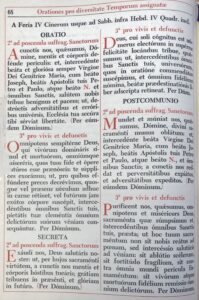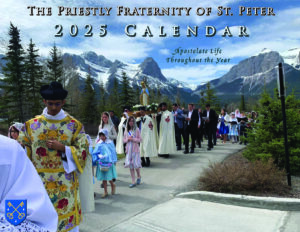Praying for the Dead during Lent
by Fr. William Rock, FSSP
In February of A.D. 2025, the New Liturgical Movement blog published an article in four parts entitled “The Antiquity and Universality of Fore-Lent” by Mr. Henri de Villiers (part 1, part 2, part 3, part 4). In the first and fourth parts, Mr. de Villiers explains:
The reminder of human fragility, meditation on the last things, and consequently, prayer for the dead, are recurrent elements of this liturgical season.
Just as the liturgy of Fore-Lent reminds us of our mortal condition fallen though [sic] sin, this period has also become in many liturgical traditions a privileged time to pray for the dead.
In the Armenian Rite, the Thursday of Quinquagesima (the last before the beginning of Lent) is dedicated to the commemoration of all the faithful departed. The same holds true for the Saturday before the Sunday of the Last Judgment in the Byzantine Rite; this is attested in the Typikon of the Great Church in the 9th or 10th century, the most important document describing the arrangement of services at Hagia Sophia. The Assyro-Chaldean rite has a similar observance on the Friday of the second week before Lent.
Among the Maronites, the three Sundays of Fore-Lent are dedicated to the commemoration of the dead, the first to deceased priests, the second to the “just and righteous”, the last to all the faithful departed. The arrangement of the season among the Syrian Jacobites is undoubtedly the more primitive: the fast of the Ninevites from Monday to Friday of Septuagesima week, the Sunday of prayer for deceased priests on Sexagesima, and for all the faithful departed on Quinquagesima.

So far as I am aware, it was never the practice of the Roman church to pray for the dead during the season of Septuagesima (the Roman Fore-Lent) and, supportingly, Mr. de Villiers does not give a Roman example of such a practice in his exposition. There is, however, the tradition of praying for the dead (and living), motivated, in all likelihood, by the same above-mentioned considerations, in the seasonal orations for the first four weeks of Lent.1 Seasonal orations are two sets of three prayers assigned for specific liturgical seasons which are to be added after the prayers of the Mass on days observed as semi-doubles or simples.2 The inclusion of additional oration sets beyond that of the Mass being celebrated “became a feature of the Carolingian liturgy,” that is, the liturgy as celebrated during the Carolingian era within the Carolingian Empire (A.D. 800–887), and “reached Rome about the 12th century.”3 A systemization of assigning prayer sets to the different liturgical seasons is attested to by the Tridentine Missal promulgated by Pope Pius V. These seasonal orations remained in the Roman Missal until the changes made under Pope Pius XII in the 1950s. After these changes, these sets of prayers are still present in the Missal and can be used ad libitum by the celebrant according to the rubrics, but seasonal orations as such are no longer assigned. Relative to the discussion here, it is the second set of seasonal orations for the season of Lent that contains the previously mentioned prayers for the living and dead (pro vivis et defunctis). It should be noted that these prayers for the living and dead are not used as seasonal orations at any other time of the year.
The translations of these prayers are as follows:
Collect (opening prayer): O almighty and eternal God, Who hast dominion over the living and the dead, and art merciful to all Whom Thou knowest will be Thine by faith and good works: we humbly beseech Thee, that they, for whom we have proposed to offer our prayers, whether this world still retains them in the flesh, or the next world hath already received them divested of their bodies, may, by the clemency of Thine own goodness, and the intercession of Thy Saints, obtain pardon and full remission of their sins. Through, etc.
Secret (prayer over the oblations): O God, to Whom alone is known the number of Thine elect to be placed in eternal bliss: grant, we beseech Thee, by the intercession of all Thy Saints, that the book of predestination may contain the names of all those for whom we have undertaken to pray, as well as those of all the faithful. Through, etc.
Postcommunion (closing prayer): May the mysteries we have received, purify us, we beseech Thee, O almighty and merciful God; and grant by the intercession of all Thy Saints, that this Thy Sacrament may not increase our guilt to punishment, but be a means of obtaining pardon in order to salvation. May it wash away sin, strengthen our frailty, secure us against the dangers of the world; and procure forgiveness for all the faithful, both living and dead. Through, etc.4
It is worth noting that there is an invoking of the intercession of the Saints, a staple of Catholic practice, in all three orations. The Collect notably expresses the Catholic belief that both faith and meritorious good works (divinized/supernaturalized/elevated good works performed in a state of grace and animated by the Infused Virtues) are necessary for salvation. Also of interest is the petition in the Postcommunion that Holy Communion was received by all worthily so that it will be for their benefit as a Sacrament and not their detriment as a sacrilege. Another interesting feature is the presence in the Collect and Secret of references to God’s foreknowledge of the saved and predestination, both great mysteries.
These Lenten prayers for the living and dead rang in the ears of our Catholic forefathers for many centuries and helped shape the way they understood Lent. May these translations and short comments similarly help you, dear reader.
Fr. William Rock, FSSP was ordained in the fall of 2019 and is currently assigned to St. Stanislaus Parish in Nashua, NH.
In support of the causes of Blessed Maria Cristina, Queen, and Servant of God Francesco II, King
- There are indications in the Roman liturgy that sin and death, and by extension the other Last Things, are themes of the season of Lent in the Roman Tradition. One of the most striking is the formula for the imposition of Ashes at the start of Lent – “Remember man, that thou art dust, and into dust thou shalt return.”
- In some seasons there would be a choice for the prayers of the third set. Also, there could be cases where only one of the two possible seasonal prayers would be said, such as if there be a commemoration.
- King, Archdale A. Liturgy of the Roman Church. (London: Longmans, Green, and Co Ltd, 1957), p. 244.
- Guéranger, Prosper. The Liturgical Year, vol. 4 (Septuagesima). Trans. Shepherd, Laurence. (Fitzwilliam: Loreto Publications, 2000), pp. 211, 216-217, 218.
April 1, 2025









